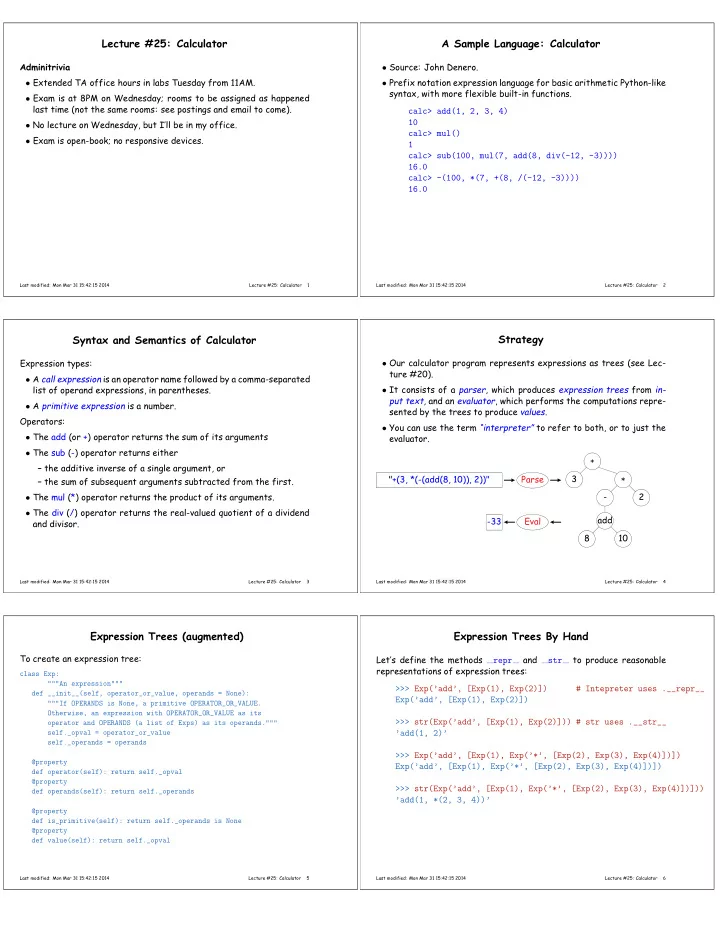

Lecture #25: Calculator A Sample Language: Calculator Adminitrivia • Source: John Denero. • Extended TA office hours in labs Tuesday from 11AM. • Prefix notation expression language for basic arithmetic Python-like syntax, with more flexible built-in functions. • Exam is at 8PM on Wednesday; rooms to be assigned as happened last time (not the same rooms: see postings and email to come). calc> add(1, 2, 3, 4) 10 • No lecture on Wednesday, but I’ll be in my office. calc> mul() • Exam is open-book; no responsive devices. 1 calc> sub(100, mul(7, add(8, div(-12, -3)))) 16.0 calc> -(100, *(7, +(8, /(-12, -3)))) 16.0 Last modified: Mon Mar 31 15:42:15 2014 Lecture #25: Calculator 1 Last modified: Mon Mar 31 15:42:15 2014 Lecture #25: Calculator 2 Syntax and Semantics of Calculator Strategy Expression types: • Our calculator program represents expressions as trees (see Lec- ture #20). • A call expression is an operator name followed by a comma-separated • It consists of a parser , which produces expression trees from in- list of operand expressions, in parentheses. put text , and an evaluator , which performs the computations repre- • A primitive expression is a number. sented by the trees to produce values . Operators: • You can use the term “interpreter” to refer to both, or to just the • The add (or +) operator returns the sum of its arguments evaluator. • The sub (-) operator returns either + – the additive inverse of a single argument, or 3 "+(3, *(-(add(8, 10)), 2))" Parse * – the sum of subsequent arguments subtracted from the first. • The mul (*) operator returns the product of its arguments. - 2 • The div (/) operator returns the real-valued quotient of a dividend add -33 Eval and divisor. 8 10 Last modified: Mon Mar 31 15:42:15 2014 Lecture #25: Calculator 3 Last modified: Mon Mar 31 15:42:15 2014 Lecture #25: Calculator 4 Expression Trees (augmented) Expression Trees By Hand To create an expression tree: Let’s define the methods and to produce reasonable repr str representations of expression trees: class Exp: """An expression""" >>> Exp(’add’, [Exp(1), Exp(2)]) # Intepreter uses .__repr__ def __init__(self, operator_or_value, operands = None): Exp(’add’, [Exp(1), Exp(2)]) """If OPERANDS is None, a primitive OPERATOR_OR_VALUE. Otherwise, an expression with OPERATOR_OR_VALUE as its >>> str(Exp(’add’, [Exp(1), Exp(2)])) # str uses .__str__ operator and OPERANDS (a list of Exps) as its operands.""" ’add(1, 2)’ self._opval = operator_or_value self._operands = operands >>> Exp(’add’, [Exp(1), Exp(’*’, [Exp(2), Exp(3), Exp(4)])]) @property Exp(’add’, [Exp(1), Exp(’*’, [Exp(2), Exp(3), Exp(4)])]) def operator(self): return self._opval @property >>> str(Exp(’add’, [Exp(1), Exp(’*’, [Exp(2), Exp(3), Exp(4)])])) def operands(self): return self._operands ’add(1, *(2, 3, 4))’ @property def is_primitive(self): return self._operands is None @property def value(self): return self._opval Last modified: Mon Mar 31 15:42:15 2014 Lecture #25: Calculator 5 Last modified: Mon Mar 31 15:42:15 2014 Lecture #25: Calculator 6
Evaluation Applying Operators Evaluation discovers the form of an expression and then executes a Calculator has a fixed set of operators that we can enumerate corresponding evaluation rule. def calc_apply(operator, args): • Primitive expressions (literals) “evaluate to themselves” (corresponds """Apply the named operator to a list of args (which are numbers). to Exps evaluating to their .values.) if operator in (’add’, ’+’): return sum(args) • Call expressions are evaluated recursively, following the tree struc- if operator in (’sub’, ’-’): ture: if len(args) == 0: – Evaluate each operand expression, collecting values as a list of raise TypeError(operator + ’requires at least 1 argument’) arguments. if len(args) == 1: – Apply the named operator to the argument list. return -args[0] return sum(args[:1] + [-arg for arg in args[1:]]) def calc_eval(exp): etc. """Evaluate a Calculator expression.""" if exp.is_primitive: return exp.value else: Last modified: Mon Mar 31 15:42:15 2014 Lecture #25: Calculator 7 Last modified: Mon Mar 31 15:42:15 2014 Lecture #25: Calculator 8 Read-Eval-Print Loop Parsing: Lexical and Syntactic Analysis The user interface to many programming languages is an interactive • To parse a text is to analyze it into its constituents and to describe loop that their relationship or structure. • Reads an expression from the user • Thus, we can parse an English sentence into nouns, verbs, adjectives, etc., and determine what plays the role of subject, what is plays the • Parses the input to build an expression tree role of object of the action, and what clauses or words modify what. • Evaluates the expression tree • When processing programming languages, we typically divide task • Prints the resulting value of the expression into two stages: – Lexical analysis (aka tokenization): Divide input string into mean- def read_eval_print_loop(): ingful tokens , such as integer literals, identifiers, punctuation """Run a read-eval-print loop for calculator.""" marks. while True: – Syntactic analysis: Convert token sequence into trees that re- try: flect their meaning. expression_tree = calc_parse(input(’calc> ’)) print(calc_eval(expression_tree)) except: print error message and recover Last modified: Mon Mar 31 15:42:15 2014 Lecture #25: Calculator 9 Last modified: Mon Mar 31 15:42:15 2014 Lecture #25: Calculator 10 Parsing Strategy Tokenization • In principle, we could dispense with tokenizing and go from text to trees directly, but "+(3, *(- (add(8, 10)), 2))" • We choose to break input into these particular chunks because they correspond to how we think about and describe the text, and thus make analysis simpler: Tokenize – We say “the word ‘add’ ”, not “the character ‘a’ followed by the character ‘d’. . . ” – We don’t mention spaces at all. [’+’, ’(’, ’3’, ’,’, ’*’, ’(’, ’-’, ’(’, ’add’, ’(’, ’8’, . . . ] • In production compilers, the lexical analyzer typically returns more information, but the simple tokens will do for this problem. Analyze + 3 * . . . . . . Last modified: Mon Mar 31 15:42:15 2014 Lecture #25: Calculator 11 Last modified: Mon Mar 31 15:42:15 2014 Lecture #25: Calculator 12
Recommend
More recommend